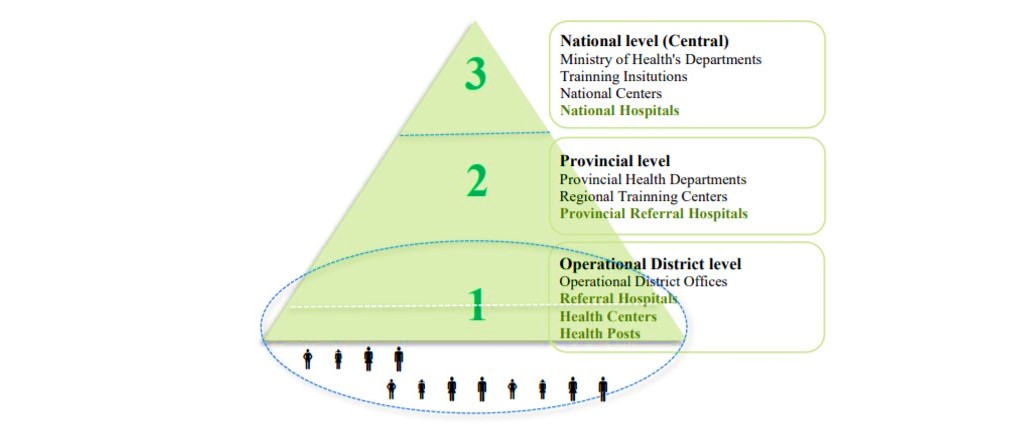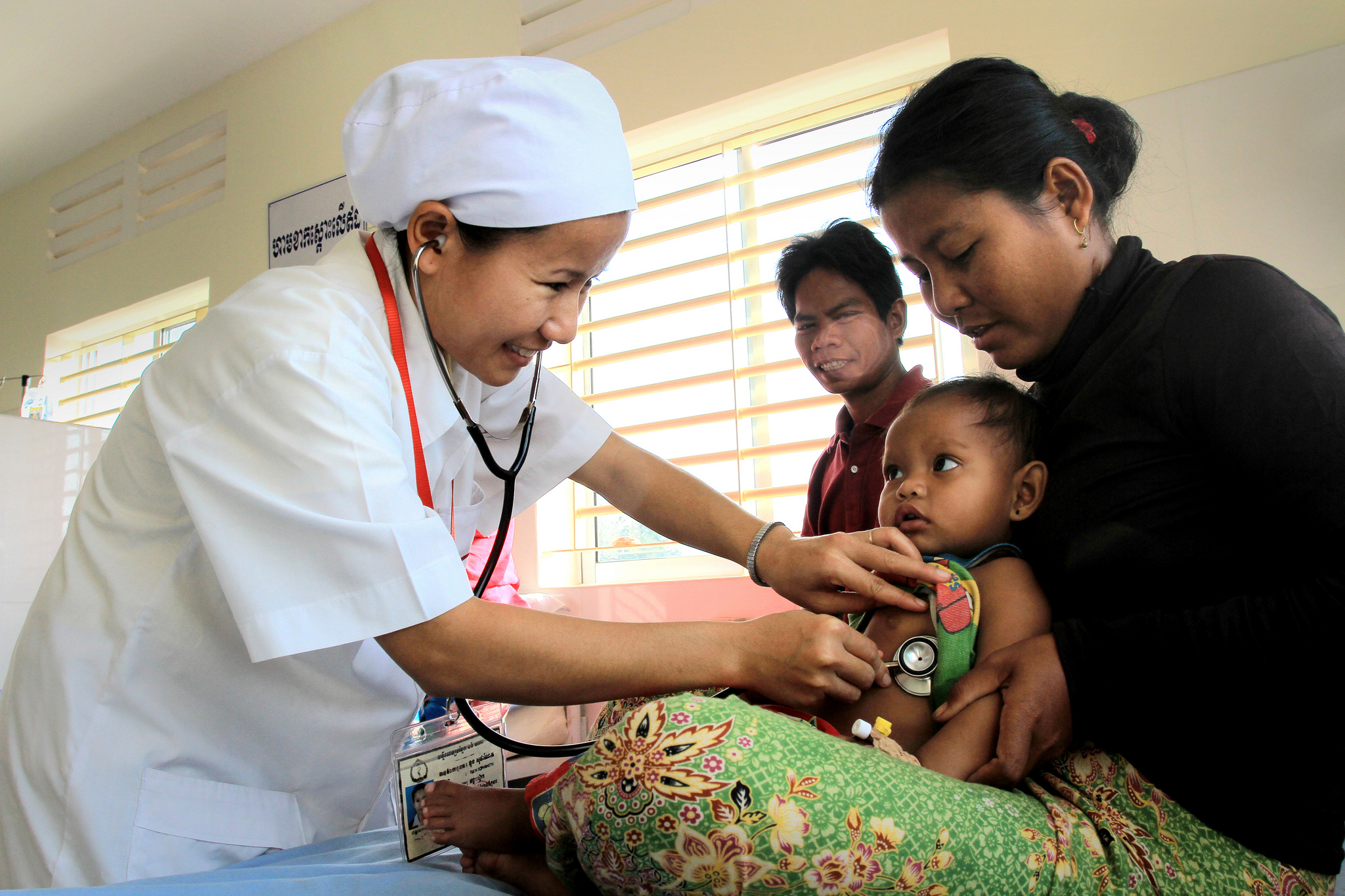After the end of the Khmer Rouge regime, Cambodia’s entire health sector including the health system, health facilities and equipment were completely destroyed.1 Since the 1990s, the Royal Government of Cambodia has placed a strong emphasis on recovering and improving the country’s health sector. In Cambodia around 2 million people live below the poverty line and a further 4.5 million citizens remain in a near-poor social class, with more thanof the poor living in the countryside.2 Better healthcare services and delivery is necessary not only to ensure their well-being but also to reduce poverty and promote social equality in the country.3
In the kingdom, the Ministry of Health is the main body responsible for all health-related issues.4 The Ministry has the duty of enhancing the health and well-being of the population across the nation through networks of health centers and hospitals.5 Cambodia’s health system can be characterized by two main types of service providers, public and private. The public health service refers to hospitals, health centers and services provided by the government under the national healthcare budget.6 Private healthcare services include for-profit and not-for-profit health organizations.7

Prasat Bakong Health Center in Siem Reap province in 2018. Photo by Open Development Cambodia. License under CC BY-SA 4.0.
Public health facilities such as health centers and hospitals have flourished at a notable pace, especially in urban areas in the last decades. As of 2015, there are 102 referral hospitals including 9 National hospital, 25 Municipal/Provincial health department and 68 district-based hospital across the country.8 There are also 1,141 health center and 107 health post.9 At the same time, there is also a growing pool of health professionals in different fields. In terms of private ownership, medium and small-size clinics and pharmacies have also grown in cities and provinces. The public health system in Cambodia has diversified into different categories including in and outpatient care, oncology (treatment of cancer), emergency care, pharmaceutical care, mental health care, dental care, rehabilitation and long-term care.10
Table: Statistic of private health providers by type of services from 2009 to 2015
Source: The Health Sector Program Report 2015 (MOH) , revived from HSP 2016-2020.| Type of Services | 2009 | 2010 | 2011 | 2012 | 2013 | 2014 | 2015 |
|---|---|---|---|---|---|---|---|
| Nursing Care Room | 758 | 1,252 | 1,504 | 1,733 | 1,630 | 1,745 | 3,392 |
| Pregnancy Care Room | 242 | 331 | 427 | 485 | 520 | 506 | 1,030 |
| Physiotherapy Room | 5 | 12 | 19 | 21 | 22 | 20 | 13 |
| Consultation Cabinet | 2,268 | 2,516 | 2,473 | 2,640 | 2,768 | 2,732 | 2,891 |
| Dental Consultation | 282 | 313 | 318 | 368 | 411 | 419 | 758 |
| Dental Clinic | 29 | 26 | 33 | 36 | 39 | 38 | 41 |
| Esthetic/Beauty Center | - | 2 | 6 | 6 | 8 | 10 | 12 |
| Medical Laboratory | 29 | 26 | 20 | 23 | 27 | 27 | 38 |
| Maternity | 8 | 7 | 7 | 7 | 7 | 8 | 11 |
| Clinic | 95 | 102 | 110 | 130 | 156 | 181 | 244 |
| Hospital | 37 | 36 | 41 | 48 | 48 | 51 | 47 |
According to the Ministry of Health, there were 8,488 private health providers/facilitators in Cambodia in 2015.11 There are also around 2,156 pharmacies operating across the country. Private health services are usually seen in urban areas where the population is dense and able to financially support their business.12 Different categories of private health service include nursing care, clinics, polyclinics, hospitals and pregnancy care. Many local and international organizations also play a vital part in Cambodia’s health sector, with non-profit health facilities established at district and community level to support the poor in rural areas. In 2015, there were over 180 NGOs working in the health sector.13

Figure 1: The Three Level of Public Health System. Source: Health Strategic Plan 2016-2020.
Cambodia’s public health system is divided into three levels14:
- National or Central Level (3rd Level)
- Provincial Level (2nd Level)
- Operational District Level (1st Level).
Each level holds different responsibilities and is categorized by different criteria including population size, accessibility and level of population density in the area.
Table: Criteria for establishment of health facilities
| Facility | Population size | Accessibility (Distance) |
|---|---|---|
| Health Center | Optimal size: 10,000 Range: 8,000 to 12,000 | Within 10km or 2hrs walk maximum for the catchment area population. |
| Referral Hospital | Optimal size size: 100,000 Range: 80,000 to 200,000 | In populated area; within 2 hours drive or boat journey and in rural areas; not more than 3 hours drive or boat journey. |
| Health Post | Range: 2,000 to 3,000 | Distance from a commune or village to the nearest HC is more than 15km, with a geographical barrier (River, mountain, or poor roads) |
An interactive map of health facilities in 2010
Cambodians can benefit from various social health protection schemes established by the government such as Health Equity Funds (HEF), civil servant health schemes and the National Social Security Fund (NSSF).15 Since 2016, the Health Equity Fund (HEF) has provided the poor free access to outpatient care, with around 2.6 million outpatient visits and 190,000 hospital admissions annually.16 The NSSF, created in 2016, is the latest social health insurance programme of the government, protecting and serving the workers with employment injury schemes.17 It aims to reduce social burdens and enhance social stability.18 Its healthcare schemes include medical care service and a daily allowance for patients who are absent from work due to injury and maternity leave.19
Health facilities signed agreement for occupational risk and health care scheme (NSSF)
Out of the country’s 17 million population, 30% use public health services while the rest choose to go to private ones.20 This has led to a huge amount of out-of-pocket spending on health services in 2017 that accounted for around 60% of current health expenditure.21 While total health expenditure is 5.9% 22of the country’s GDP, expenditure per capita was around $82.23 Hospital bed density, an indicator to measure in-patient service availability, was 1.9 beds per 1000 population in 2018. 24
According to a UNDP report, Cambodia stands at 0.581 in the Human Development Index (HDI), categorized in the medium human development countries and ranked 146 out of 189. This statistic shows an increase of 51.4 percent since 1990.25. Life expectancy stands at 69.6 years, a 16 year increase compared to 1990.26 The death rate is 7.3deaths per 1000 population in 2020.27 This shows significant improvement in the health sector in the last few decades.

A trained medical staff listens to the heartbeat of an infant at 16 Makara hospital in Preah Vihear, Cambodia. Photo by The World Bank, taken on 30 January 2013. Licensed under CC BY-NC-ND 2.0.
Despite great improvement, Cambodia faces many challenges against both communicable and non-communicable disease prevention including the long-lasting fight against HIV/AIDs, malaria, tuberculosis, dengue fever and access to clean water.28 Maternal and child mortality, malnutrition, the growing numbers of people with mental illness and the potential health problems from climate change are threats to Cambodia’s health system development. 29
Enhancing public health is essential for human capital development. Recognizing this problem, Cambodia has undertaken various reforms under different strategies and policy frameworks to ensure quality primary public healthcare services delivery. Public health is among the top priorities for development in the Rectangular Strategy Phase IV of the government. In 2018, the Royal Government of Cambodia allocated around $485 million of the budget on the health sector.30
Other pages related to health center:
- Services delivery at health center
- Health care policy and administration
- Priority health concerns
- Maternal and child health
References
- 1. Laura McGrew, “Health Care in Cambodia,” Cultural Survival, September 1, 1990.
- 2. “Cambodia Overview,” World Bank, October 14, 2020.
- 3. Robert Kolesar, Comparing Social Health Scheme in Cambodia ,Washington: Health Policy Plus, 2019.
- 4. Peter Leslie Annear et al., The Kingdom of Cambodia Health System Review, vol. 5, WHO, 2015.
- 5. Ibid.
- 6. Sanjay Basu et al., “Comparative Performance of Private and Public Healthcare Systems in Low- and Middle-Income Countries: A Systematic Review,” PLoS Medicine 9, no. 6 , 2012.
- 7. Ibid.
- 8. Ministry of Health, “Health Strategic Plan 2016-2020”, 2016.
- 9. ibid.
- 10. Peter Leslie Annear et al., The Kingdom of Cambodia Health System Review, vol. 5, WHO, 2015.
- 11. Ministry of Health, “Health Strategic Plan 2016-2020”, 2016.
- 12. Ibid.
- 13. Ibid.
- 14. Ibid
- 15. Robert Kolesar, Comparing Social Health Scheme in Cambodia ,Washington: Health Policy Plus, 2019.
- 16. “Cambodia: Reducing Poverty and Sharing Prosperity,” World Bank, October 29, 2019,
- 17. National Social Security Fund, accessed December 12, 2020.
- 18. Ibid.
- 19. Ibid.
- 20. “Health Care in Cambodia”, October 7, 2014.
- 21. “Out-of-Pocket Expenditure” World Health Organization, accessed December 15, 2020.
- 22. “The World Factbook: Cambodia,” Central Intelligence Agency (Central Intelligence Agency), February 1, 2018.
- 23. “Current Health Expenditure per Capita,” World Health Organization, accessed December 15, 2020, .
- 24. Ministry of Health, “Health Strategic Plan 2016-2020”, 2016.
- 25. “Human Development Report Cambodia 2019” (United Nation Development Program(UNDP)
- 26. “Human Development Reports,” accessed December 13, 2020.
- 27. “The World Factbook: Cambodia,” Central Intelligence Agency), February 1, 2018.
- 28. Ministry of Health, “Health Strategic Plan 2016-2020”, 2016.
- 29. Ibid.
- 30. Kong Meta, “PM Approves 2019 Budget,” Phnom Penh Post, October 29, 2018.

